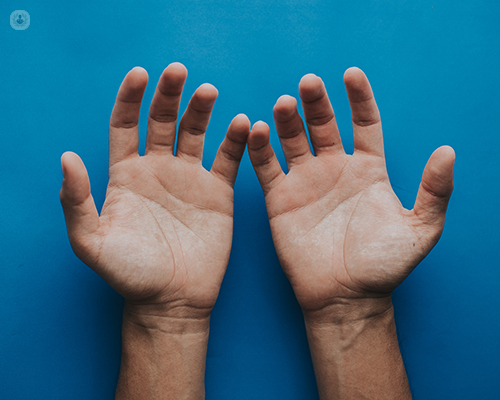Frequently asked questions about Dupuytren's contracture
Written in association with:Dupuytren's contracture is a condition which causes fingers to bend, resulting in difficulty in straightening them. Experienced consultant hand and wrist surgeon Mr Tim Halsey explains the condition, including its symptoms, causes and treatment options.
What is Dupuytren’s contracture?
Dupuytren’s contracture is a condition which presents with an abnormal thickening of fascia within the hand. The fascia is a layer of connective tissue beneath the skin in the palm of the hand and within the fingers. This tissue may develop a hard lump (nodule) or a thick band (cord).

The condition is usually painless and causes one or more fingers to bend toward the palm of the hand, meaning that the affected fingers cannot straighten completely
What are the symptoms of Dupuytren's contracture?
Dupuytren's contracture may cause a range of symptoms, including;
- Difficulty with washing yourself, shaking hands or letting go of things.
- Wearing gloves, putting your hands in pockets and holding things can be difficult.
- The presence of one or more small tender lumps (nodules) in the palm.
- Inability to lay the palm of the hand flat on the table (Heuston’s table-top test).
The tenderness of the nodules will be reduced after some time, while they may thicken and contract, or in some cases, tighten. If this occurs, thick cords of tissue may develop.
What causes Dupuytren's contracture?
The cause of Dupuytren’s contracture is unknown. That being said, experts have found that the condition is often genetic, and you are more at risk of developing the condition if a family member suffers from it. Some people have a strong family history and can have it in the soles of their feet too. They tend to present at a younger age and have more aggressive contractures.
Who is prone to Dupuytren's contracture?
Dupuytren’s contracture is much more common in men than in women. It is also more likely to develop in individuals over the age of 50 and in those predisposed to the condition, due to genetics.
How is Dupuytren's contracture treated?
There are several treatment options available for Dupuytren’s contracture, these include:
- Needle aponeurotomy; dividing the cord with a needle.
- Fasciotomy; dividing the cord with an operation.
- Collagenase injection; dividing the cord with an enzyme named collagenase.
- Fasciectomy; removing the cord, or part of it.
- Dermo-fasciectomy; removing the cord and overlying skin, covering the wound with a skin graft, often from the arm.
Following surgery patients require physical therapy, as a means of maintaining the finger’s mobility post-surgery to optimise function.
If you would like to book a consultation with Mr Halsey, do not hesitate to do so by visiting his Top Doctors profile today.


